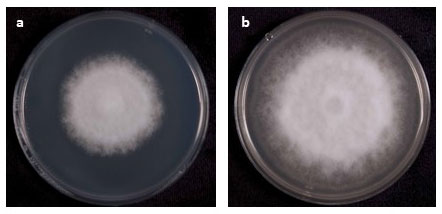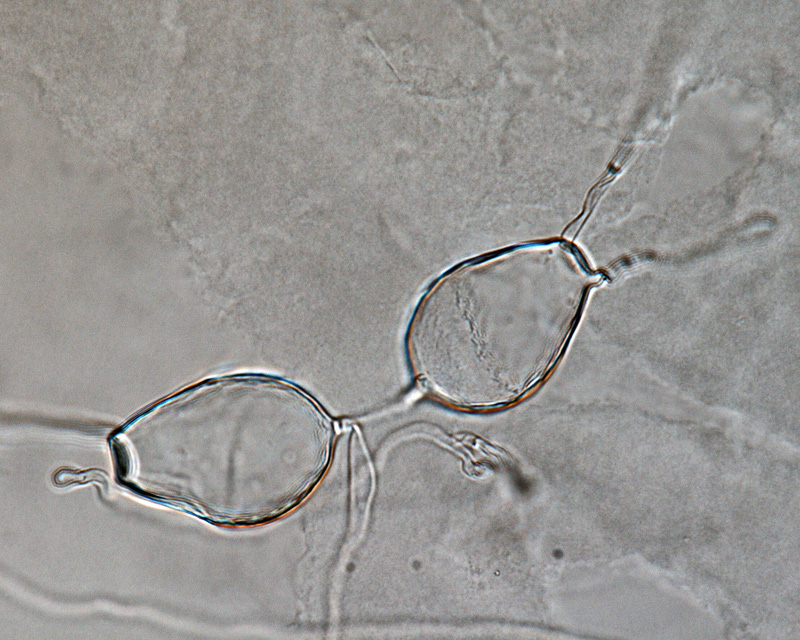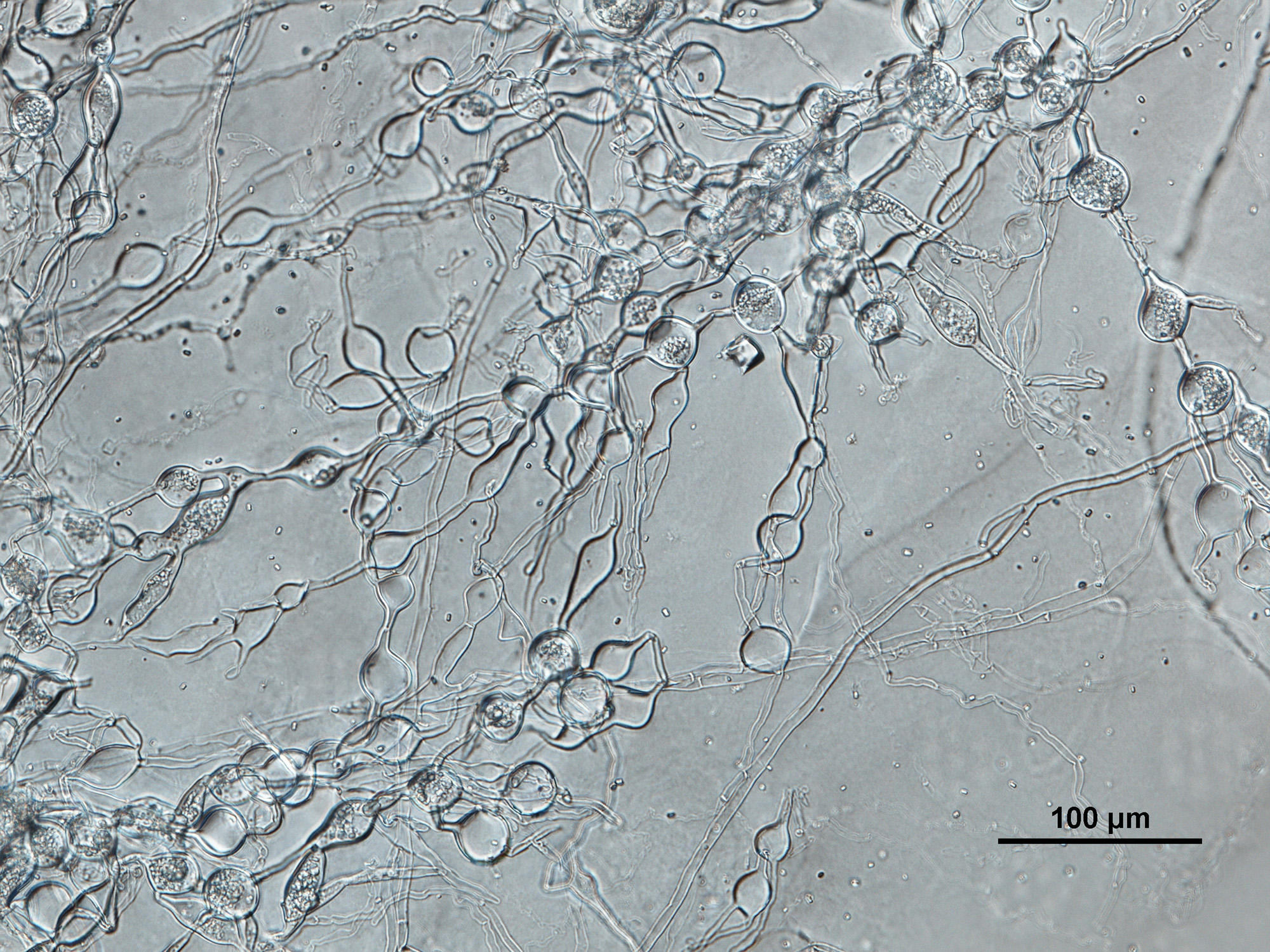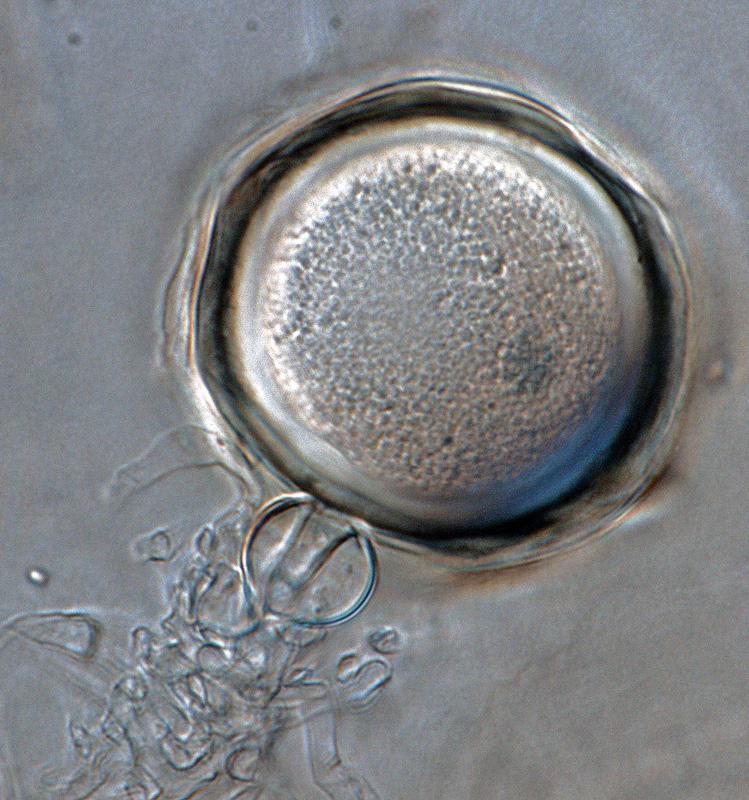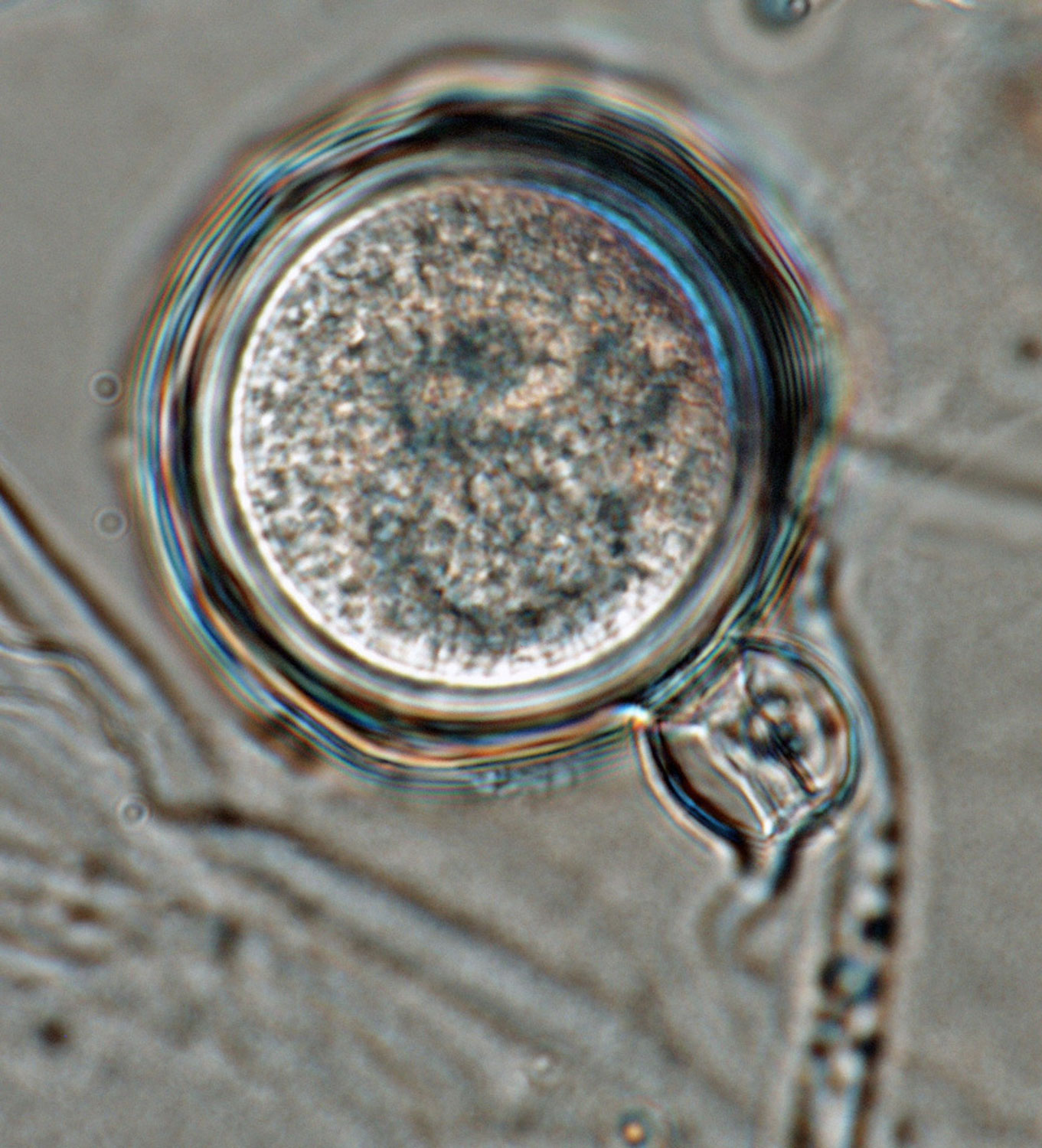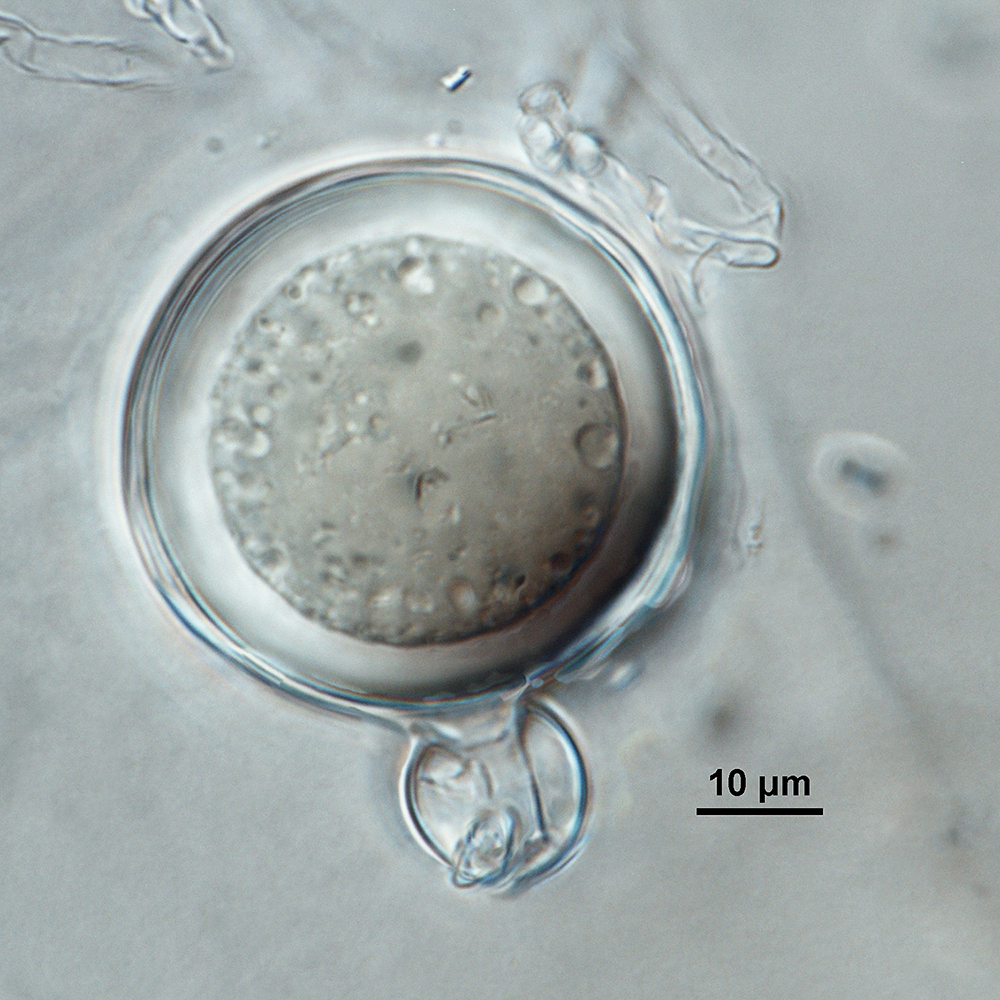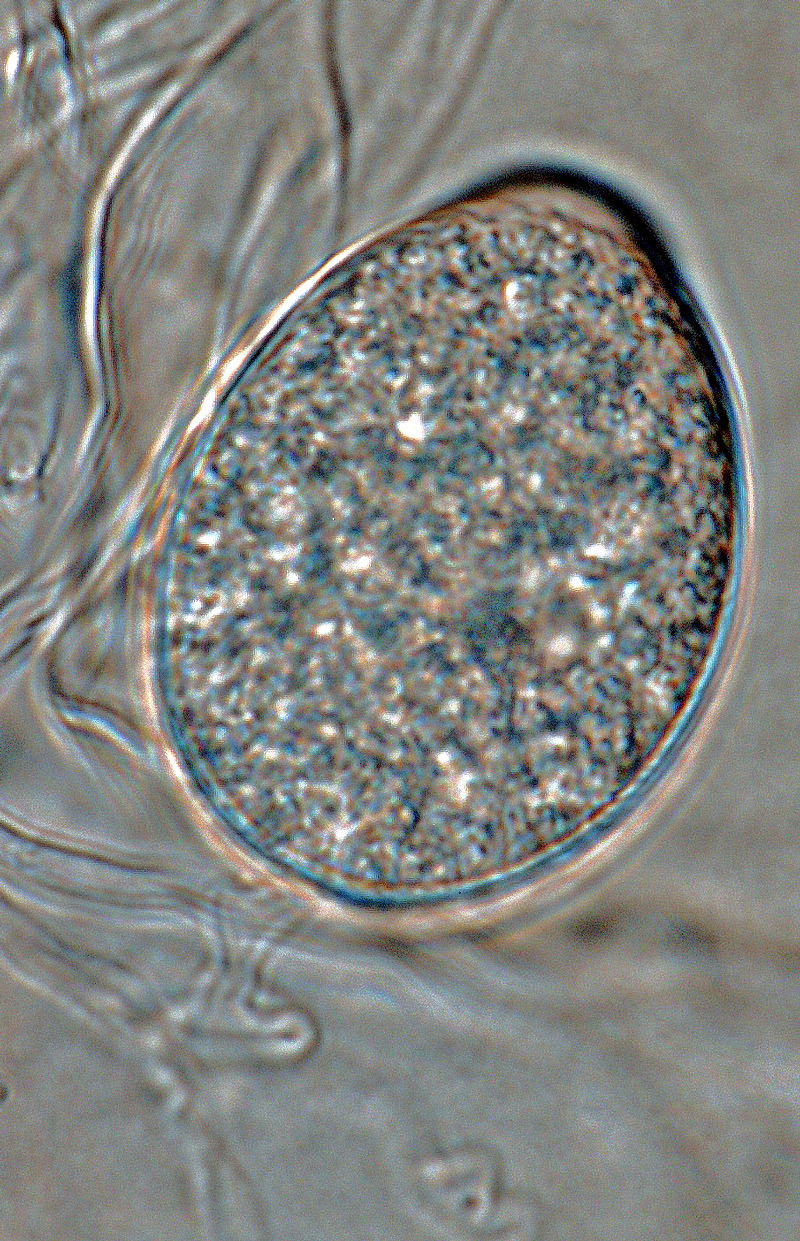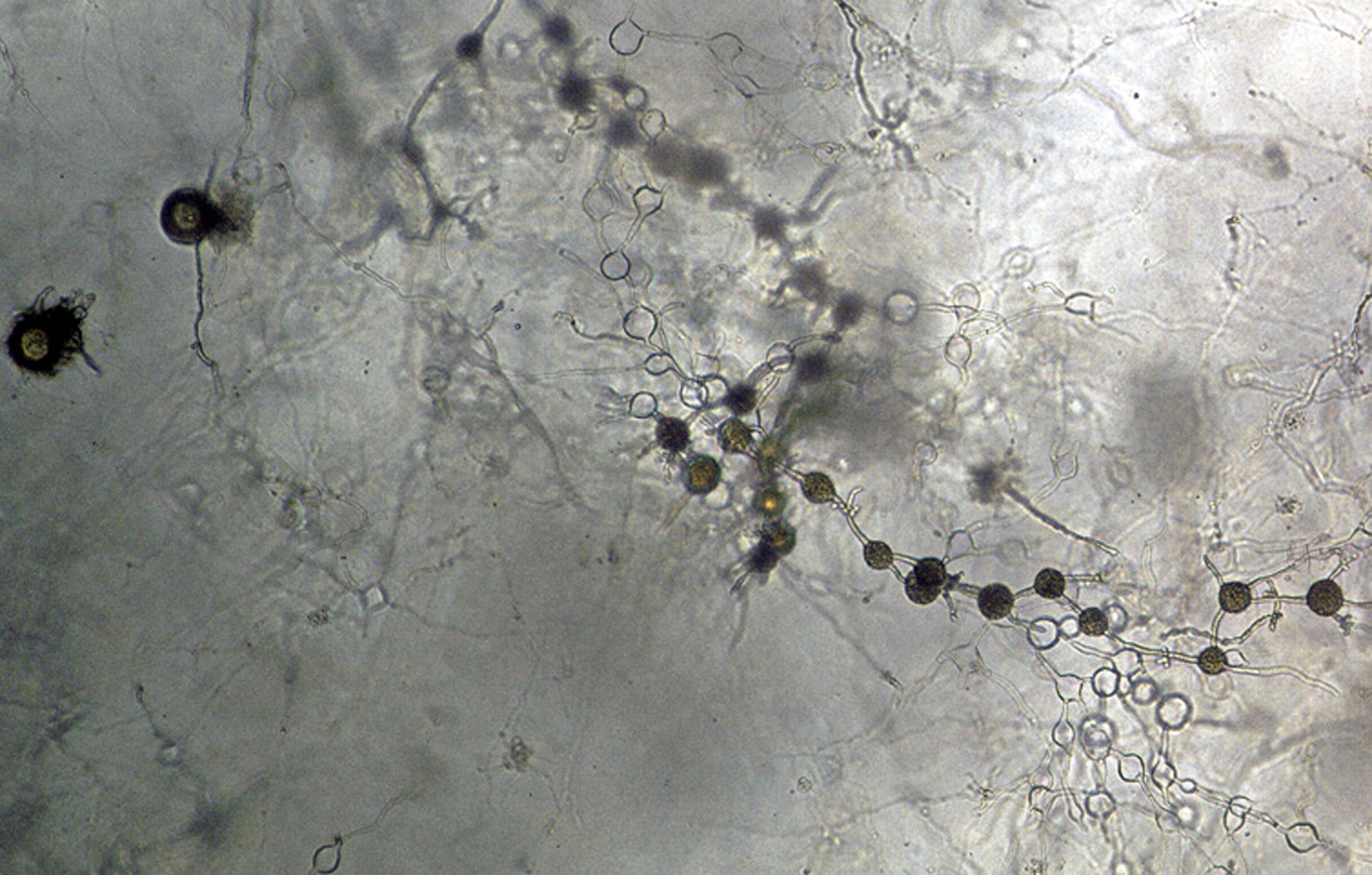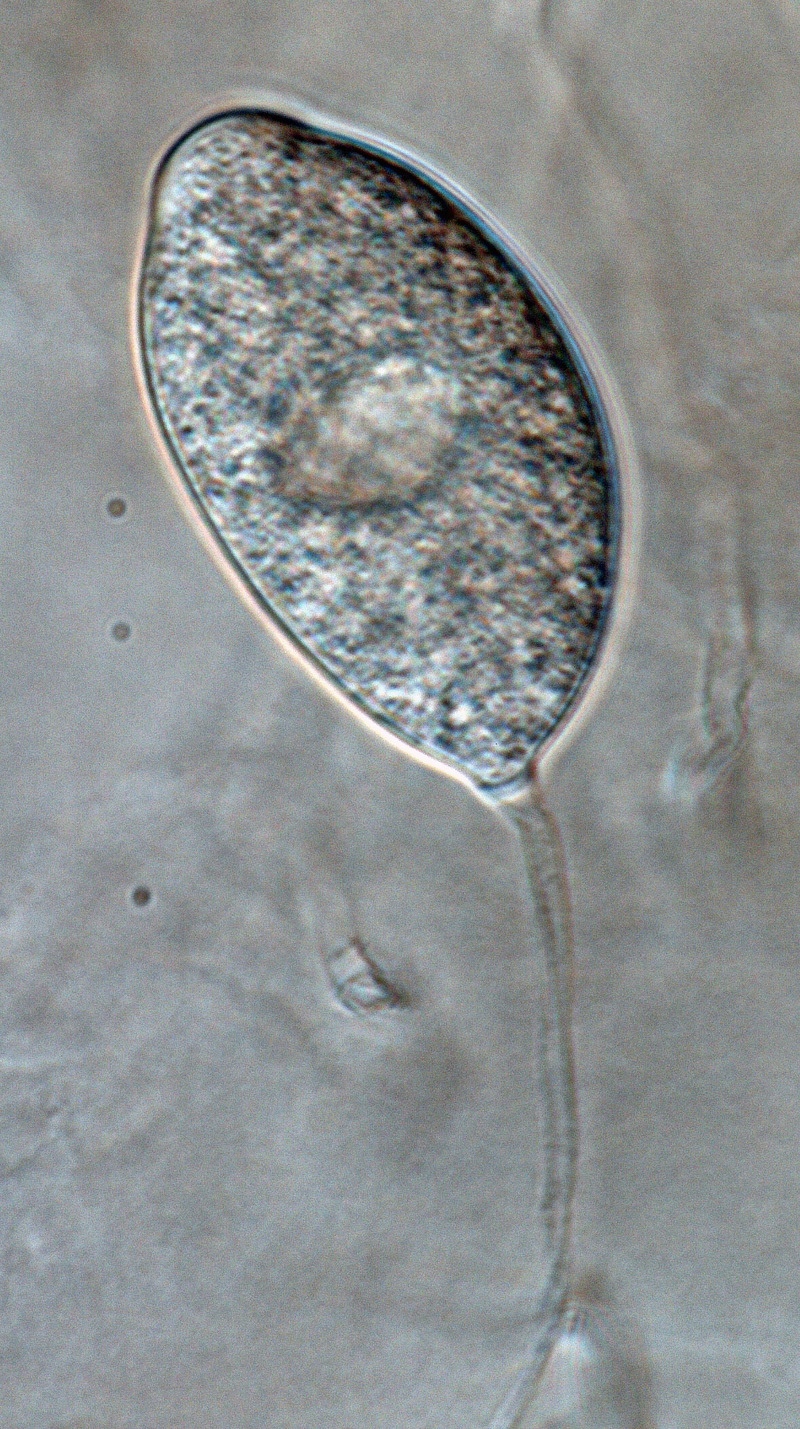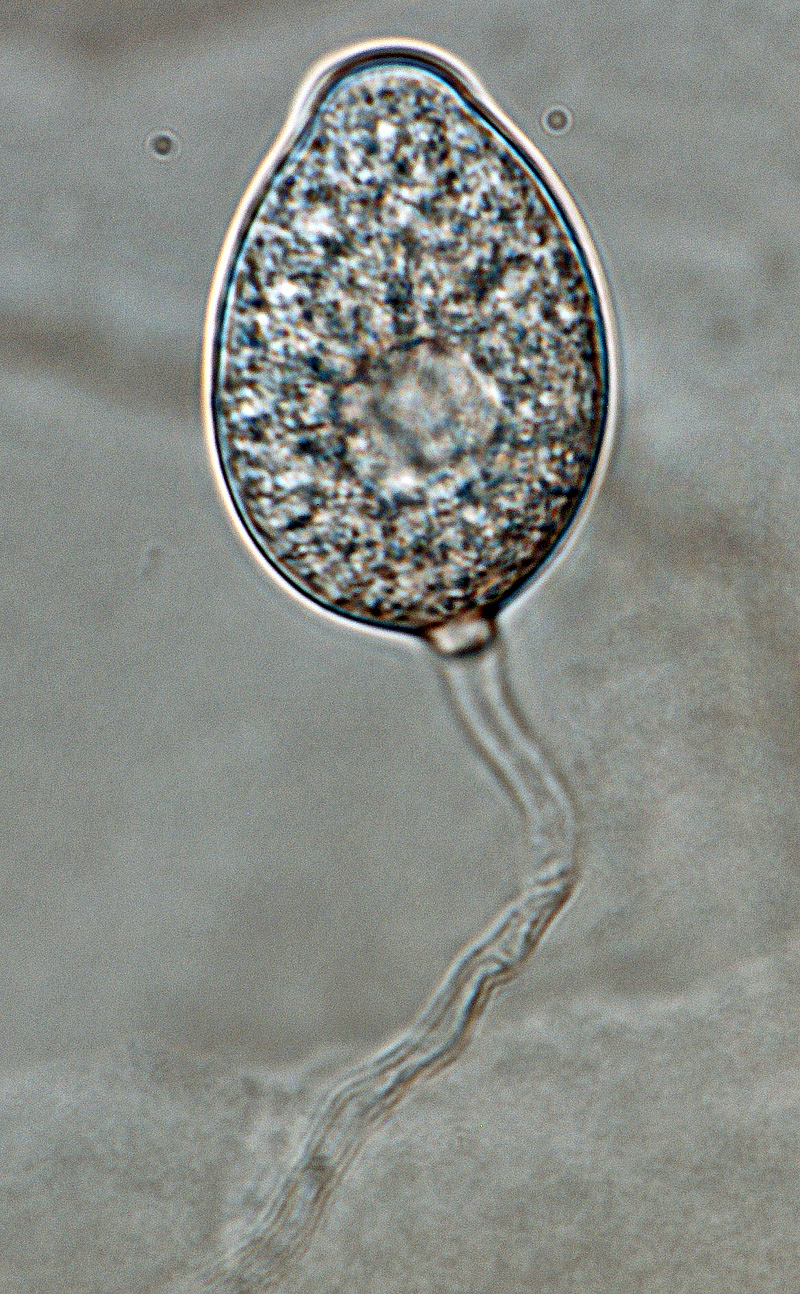Phytophthora multivesiculata
|
Phytophthora spp. in Clade 2e: portion of the seven-loci ML phylogeny featuring the type cultures of 212 described species (by T. Bourret). Notice the position of P. multivesiculata Ex-type CBS 545.96 = S&T BL 50G. Gloria Abad, USDA S&T.
|
|
Phytophthora spp. in Clade 2e: Morphological Tabular key (PDF) and Tabular key legends (PDF) in IDphy2 KEY SECTION. Notice the data of P. multivesiculata Ex-type CBS 545.96 = S&T BL 50G. Gloria Abad, USDA S&T.
|
|
Phytophthora multivesiculata (CPHST BL 50G, ex-type) colony grown for 7 days on (a) V8 agar and (b) potato dextrose agar; photos by Yilmaz Balci, USDA-APHIS-PPQ |
|
Phytophthora multivesiculata (CPHST BL 50G, ex-type) asexual phase (a–g): persistent nonpapillate sporangia (a–e), globose and catenulate hyphal swellings (f, g); photos by Gloria Abad, USDA-APHIS-PPQ. |
|
Phytophthora multivesiculata (CPHST BL 50G, ex-type) sexual phase: plerotic oospores with predominantly amphigynous antheridia with digitate projections; photos by Gloria Abad, USDA-APHIS-PPQ. |
|
Phytophthora multivesiculata (CPHST BL 50G, ex-type) asexual phase: persistent nonpapillate sporangia with external proliferation; photo by Gloria Abad, USDA-APHIS-PPQ. |
|
Phytophthora multivesiculata (CPHST BL 50G, ex-type) asexual phase: persistent nonpapillate sporangia; photo by Gloria Abad, USDA-APHIS-PPQ. |
|
Phytophthora multivesiculata (CPHST BL 50G, ex-type) asexual phase: globose and catenulate hyphal swellings; photo by Gloria Abad, USDA-APHIS-PPQ. |
|
Phytophthora multivesiculata (CPHST BL 50G, ex-type) sexual phase: plerotic oospore with predominantly amphigynous antheridium; photo by Gloria Abad, USDA-APHIS-PPQ. |
|
Phytophthora multivesiculata (CPHST BL 50G, ex-type) sexual phase: plerotic oospore with predominantly amphigynous antheridium with digitate projection; photo by Gloria Abad, USDA-APHIS-PPQ. |
|
Phytophthora multivesiculata (CPHST BL 50G, ex-type) sexual phase: plerotic oospore with predominantly amphigynous antheridium with digitate projection; photo by Gloria Abad, USDA-APHIS-PPQ. |
|
Phytophthora multivesiculata (CPHST BL 50G, ex-type) sexual phase: plerotic oospore with predominantly amphigynous antheridium with small digitate projection; photo by Gloria Abad, USDA-APHIS-PPQ. |
|
Phytophthora multivesiculata (CPHST BL 50G, ex-type) asexual phase: persistent nonpapillate sporangium; photo by Gloria Abad, USDA-APHIS-PPQ. |
|
Phytophthora multivesiculata (CPHST BL 50G, ex-type) asexual phase: globose and catenulate hyphal swellings; photo by Gloria Abad, USDA-APHIS-PPQ. |
|
Phytophthora multivesiculata (CPHST BL 50G, ex-type) asexual phase: persistent nonpapillate sporangium; photo by Gloria Abad, USDA-APHIS-PPQ. |
|
Phytophthora multivesiculata (CPHST BL 50G, ex-type) asexual phase: persistent nonpapillate sporangium; photo by Gloria Abad, USDA-APHIS-PPQ. |
Name and publication
Phytophthora multivesiculata Ilieva, Man in 't Veld, W. Veenb.-Rijks & R. Pieters (1998
Ilieva E, Man in 't Veld WA, Veenbaas-Rijks W, and Pieters R. 1998. Phytophthora multivesiculata, a new species causing rot in Cymbidium. Eur. J. Plant Pathol. 104: 677–684.
Nomenclature
from Ilieva et al. (1998)
Mycobank
Typification
Type: NETHERLANDS, Mijdrecht, isolated from leaves of Cymbidium on November, 1995, dry culture CBS 6034 deposited in herbarium Centraalbureau voor Schimmelcultures, Baarn, the Netherlands
Ex-type: CBS 545.96
Ex-type in other collections
(ET) CBS 545.96, WPC P10410, PD 95/8679, S&T BL 50G (Abad), 29E3 (Hong).
Molecular identification
Voucher sequences for barcoding genes (ITS rDNA and COI) of the ex-type (see Molecular protocols page)
Phytophthora multivesiculata isolate CPHST BL 50G (= P10410 WPC) = ITS rDNA MG865544, COI MH136937
Voucher sequences for Molecular Toolbox with seven genes (ITS, β-tub, COI, EF1α, HSP90, L10, and YPT1
(see Molecular protocols page) (In Progress)
Voucher sequences for Metabarcoding High-throughput Sequencing (HTS) Technologies [Molecular Operational Taxonomic Unit (MOTU)]
(see Molecular protocols page) (In Progress)
Sequences with multiple genes for ex-type in other sources
- NCBI: Phytophthora multivesiculata CPHST BL 50G
- NCBI: Phytophthora multivesiculata P10410
- NCBI: Phytophthora multivesiculata CBS 545.96
- NCBI: Phytophthora multivesiculata CBS545.96
- EPPO-Q-bank: Phytophthora multivesiculata CBS 545.96 (= PD 95/8679)
- BOLDSYSTEMS: Phytophthora multivesiculata OOMYA 180-07 [COI-5P:680, ITS:803] = CBS 545.96; OOMYA 533-08 [ITS:2284] = CBS 545.96 (barcoding COI & ITS)
Position in multigenic phylogeny with 7 genes (ITS, β-tub, COI, EF1α, HSP90, L10, and YPT1)
Clade clade:
a taxonomic group of organisms classified together on the basis of homologous features traced to a common ancestor
2e
Morphological identification
Colonies and cardinal temperatures
Colony colony:
assemblage of hyphae which usually develops form a single source and grows in a coordinated way
morphology after 7 days of growth on V8 agar, potato dextrose agar, and malt extract with no distinct pattern to slightly radiate. Minimum temperature for growth is 6°C, optimum 21–27°C, and maximum 30°C.
Asexual phase
SporangiaSporangia:
sac within which zoospores form, especially when water is cooled to about 10°C below ambient temperature; in solid substrates, sporangia usually germinate by germ tubes
nonpapillatenonpapillate:
pertaining to the production of a non-distinct, or inconspicuous, papilla at the distal end of the sporangium (cf. papillate and semipapillate)
, rarely with two apices; persistentpersistent:
pertaining to sporangia that remain attached to the sporangiophore and do not separate or detach easily (cf. caducous)
; ovoidovoid:
egg-shaped, with the widest part at the base of the sporangium and the narrow part at the apex
, obpyriformobpyriform:
inversely pear-shaped, i.e. with the widest part at the point of attachment (cf. pyriform)
occasionally with tapered basetapered base:
pertaining to the base of a sporangium or oogonium; funnel-shaped
(30–60 L x 20–41 W μm); sporangiasporangia:
sac within which zoospores form, especially when water is cooled to about 10°C below ambient temperature; in solid substrates, sporangia usually germinate by germ tubes
showing internal and external proliferationexternal proliferation:
formation of a sporangium after a sporangiophore has emerged from beneath and external to an empty sporangium that has previously emitted its zoospores (cf. internal proliferation)
and produced singly on long, slender, mainly twisted sporangiophores or in sympodial arrangement of 2 or 3 sporangia; some sporangiasporangia:
sac within which zoospores form, especially when water is cooled to about 10°C below ambient temperature; in solid substrates, sporangia usually germinate by germ tubes
laterally attached to sporangiophoresporangiophore:
the hyphal strand on which the sporangium is formed; may be branched or unbranched to form compound sympodia or simple sympodia
. Hyphal swellings globoseglobose:
having a rounded form resembling that of a sphere
and catenulatecatenulate:
having a chain-like form
. Chlamydospores absent.
Sexual phase
Homothallic. Oogonia smooth-walled (28–50 μm diam.); antheridiaantheridia:
the male gametangium; a multinucleate, swollen hyphal tip affixed firmly to the wall of the female gametangium (the oogonium)
predominantly amphigynousamphigynous:
pertaining to the sexual stage in which the antheridium completely surrounds the stalk of the oogonium (cf. paragynous)
, irregularly spherical or ellipsoidal, sometimes with digitated projections; oosporesoospores:
zygote or thick-walled spore that forms within the oogonium after fertilization by the antheridium; may be long-lived
pleroticplerotic:
pertaining to an oospore that fills the oogonium (cf. aplerotic)
or slightly apleroticaplerotic:
pertaining to a mature oospore that does not fill the oogonium; i.e. there is room left between the oospore wall and oogonium wall (cf. plerotic)
(24–42 μm diam.).
NOTES:
- Original publication refers to the presence of semipapillatesemipapillate:
pertaining to the production of shallow having papilla that are not well developed, shallow and less nipple-like than fully papillate structures
and nonpapillatenonpapillate:
pertaining to the production of a non-distinct, or inconspicuous, papilla at the distal end of the sporangium (cf. papillate and semipapillate)
sporangia. In our observations of the ex-type P10410, only nonpapillatenonpapillate:
pertaining to the production of a non-distinct, or inconspicuous, papilla at the distal end of the sporangium (cf. papillate and semipapillate)
sporangia have been observed. - Original manuscript refers to oosporesoospores:
zygote or thick-walled spore that forms within the oogonium after fertilization by the antheridium; may be long-lived
mostly apleroticaplerotic:
pertaining to a mature oospore that does not fill the oogonium; i.e. there is room left between the oospore wall and oogonium wall (cf. plerotic)
. OosporesOospores:
zygote or thick-walled spore that forms within the oogonium after fertilization by the antheridium; may be long-lived
of specimen P10410 are pleroticplerotic:
pertaining to an oospore that fills the oogonium (cf. aplerotic)
or slightly apleroticaplerotic:
pertaining to a mature oospore that does not fill the oogonium; i.e. there is room left between the oospore wall and oogonium wall (cf. plerotic)
.
Most typical characters
Phytophthora multivesiculata is characterized by the presence of globoseglobose:
having a rounded form resembling that of a sphere
and catenulated hyphal swellings.
Specimen(s) evaluated
Phytophthora multivesiculata ex-type CPHST BL 50G, duplicate of P10410 ex-type (World Phytophthora Collection), which is a duplicate of ex-type CBS 545.96
Hosts and distribution
Distribution: Australia, Europe (the Netherlands, type)
Substrate: leaves, stems, base of bulbs
Disease note: leaf and stem rot, bulb rot
Host: Cymbidium sp. (Orchidaceae)
Retrieved January 31, 2018 from U.S. National Fungus Collections Nomenclature Database.
Quarantine status
USA: This species was listed as a species of concern during the 2009 Phytophthora prioritization project conducted by USDA APHIS PPQ CPHST PERAL (Schwartzburg et al.).
Additional references and links
- SMML USDA-ARS: Phytophthora multivesiculata
- EPPO Global Database: Phytophthora multivesiculata
- Forest Phytophthora of the world: Phytophthora multivesiculata
- CABI Digital Library: Phytophthora multivesiculata
- Encyclopedia of Life (EOL): Phytophthora multivesiculata
- Index Fungorum (IF): Phytophthora multivesiculata
- Google All Phytophthora multivesiculata
- Google Images Phytophthora multivesiculata
- Google Scholar Phytophthora multivesiculata
Fact sheet authors
Treena Burgess, Ph.D., Phytophthora Science and Management, Harry Butler Institute, Murdoch University, Australia
Z. Gloria Abad, Ph.D., USDA-APHIS-PPQ-S&T Plant Pathogen Confirmatory Diagnostics Laboratory (PPCDL), United States of America.

